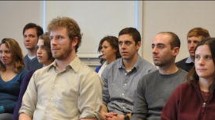Abstract
From time to time during social encounters, people look at one another in the region of the eyes, and sometimes their eyes meet to make eye-contact. According to Argyle and Dean (1965), eye-contact in dyadic encounters signals the intimacy of the interaction and is controlled largely by the competing approach and avoidance forces that motivate the pair. In the present paper, new analyses are reported of three published experiments that were designed originally to test aspects of the intimacy model and it is shown that the duration of eye-contact is no more than a chance product of how long the two subjects look individually. Looking and not eye-contact, it is argued, should be the basis for models of visual interaction, and the intimacy model is ill-founded conceptually; the role of emotion in gaze has been overstressed at the expense of the concept of information; and the most important aspect of vision is in any case not looking and eye-contact but visual access to the whole person. The more “cueless” the encounter—that is, the fewer the social cues from vision and all the other senses combined—the greater the psychological distance; and the greater the psychological distance, the more task-oriented and depersonalized the content of what people say and, in turn, the less spontaneous their style of speech and the less likely a debate to end in compromise.
Similar content being viewed by others
References
Argyle, M., & Cook, M.Gaze and mutual gaze. London: Cambridge University Press, 1976.
Argyle, M., & Dean, J. Eye-contact, distance and affiliation.Sociometry 1965,28 289–304.
Argyle, M., & Ingham, R. Gaze, mutual gaze, and proximity.Semiotica 1972,6 32–49.
Edinger, J. A., & Patterson, M. L. Nonverbal involvement and social control.Psychological Bulletin 1983,93 30–56.
Ellsworth, P. C. The meaningful look. (Review of Argyle & Cook, 1976).Semiotica 1978,24 341–351.
Hargreaves, C. P., & Fuller, M. F. Some analyses of data from eye-contact studies.British Journal of Social Psychology 1984,23 77–82.
Harper, R. G., Wiens, A. N., & Matarazzo, J. D.Nonverbal communication: The state of the art. Chichester: Wiley, 1978.
Kemp, N. J., & Rutter, D. R. Cuelessness and the content and style of conversation.British Journal of Social Psychology 1982,21 43–49.
Patterson, M. L. An arousal model of interpersonal intimacy.Psychological Review 1976,83 235–245.
Patterson, M. L. Arousal change and cognitive labelling: Pursuing the mediators of intimacy exchange.Environmental Psychology and Nonverbal Behaviour 1978,3 17–22.
Patterson, M. L. A sequential functional model of nonverbal exchange.Psychological Review 1982,89 231–249.
Patterson, M. L., Jordan, A., Hogan, M. B., & Frerker, D. Effects of nonverbal intimacy on arousal, and behavioural adjustment.Journal of Nonverbal Behavior 1981,5 184–198.
Pennington, D. C., & Rutter, D. R. Information or affiliation? Effects of intimacy on visual interaction.Semiotica 1981,35 29–39.
Rutter, D. R.Looking and seeing: The role of visual communication in social interaction. Chichester: Wiley, 1984.
Rutter, D. R., Morley, I. E., & Graham, J. C. Visual interaction in a group of introverts and extraverts.European Journal of Social Psychology 1972,2 371–384.
Rutter, D. R., & Stephenson, G. M. The functions of Looking: Effects of friendship on gaze.British Journal of Social and Clinical Psychology 1979,18 203–205.
Rutter, D. R., Stephenson, G. M., & Dewey, M. E. Visual communication and the content and style of conversation.British Journal of Social Psychology 1981,20 41–52.
Rutter, D. R., Stephenson, G. M., Lazzerini, A. J., Ayling, K., & White, P. A. Eye-contact: A chance product of individual Looking?British Journal of Social and Clinical Psychology 1977,16 191–192.
Stephenson, G. M., Rutter, D. R., & Dore, S. R. Visual interaction and distance.British Journal of Psychology 1973,64 251–257.
Strongman, K. T., Champness, B. G. Dominance hierarchies and conflict in eye contact.Acta Psychologica 1968,28 376–386.
Swain, J., Stephenson, G. M., & Dewey, M. E. Seeing a stranger: Does eye-contact reflect intimacy?Semiotica 1982,42 107–118.
Wagner, H., Clarke, A. H., & Ellgring, J. H. Eye-contact and individual looking: The role of chance.British Journal of Social Psychology 1983,22 61–62.
Additional information
Research for this article was sponsored by the Social Science Research Council of Great Britain.
Rights and permissions
About this article
Cite this article
Rutter, D.R., Pennington, D.C., Dewey, M.E. et al. Eye-contact as a chance product of individual looking: Implications for the intimacy model of argyle and dean. J Nonverbal Behav 8, 250–258 (1984). https://doi.org/10.1007/BF00985982
Issue Date:
DOI: https://doi.org/10.1007/BF00985982




